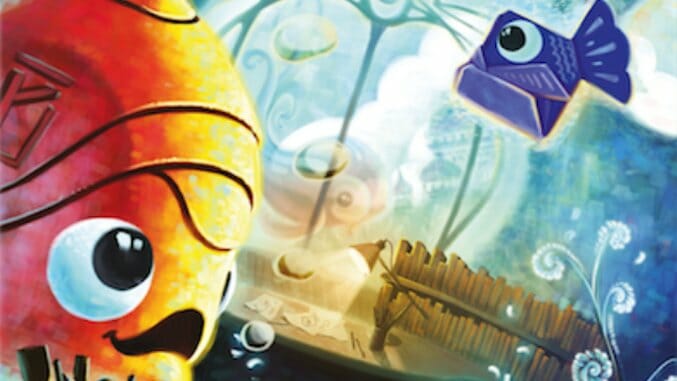
Aquarium is new to the English-speaking boardgame world, having previously had a limited release in Poland in 2011 without finding a broader audience. It’s a pretty game, with bright and often fantastical artwork with a theme that appears light, but the gameplay is harsh and unbalanced, making it a game without an obvious market.
In Aquarium, players compete to buy fish from the central “pet store” to fill their own aquariums, and score points by collecting sets. The collectible fish come in four colors and three sizes (measured by 1 to 3 stars), so players can collect by color, getting all three sizes for a set, or by size, getting one fish of each color in that specific size. This seems straightforward enough, but to buy from the pet store, you must buy all of the fish on display at once, so the cost can become an obstacle rather quickly. On a turn, you must either buy or pass; if you pass, you get two coins, which won’t get you very far toward your goal of filling your aquarium.
You also need money to feed your fish, which happens four times during the game, including the final feeding before players add up their points. The amount of food required to keep one fish alive at each feeding is equal to a number from 1 to 3, drawn randomly from a set of four cards (1, 2, 3, and 3, so, best of luck, pal), times the size of the fish. So if you buy a 3-star fish in early in the game and have to feed it four times, you could end up spending 36 coins to feed it.
The way around that is to buy plants, which cost two to three times as much as fish do but allow you to feed one fish per plant at each feeding. You can also get points for collecting a set of the three different plant types, although the face value of those three plants is 24 coins, a lot in a game where you’re constantly short of cash.
Oh, but it gets worse, and this is where the game takes a darker and hard to fathom turn. Once you say you’d like to buy the fish on display, your opponents get two opportunities to screw with you, once by altering the fish up for sale, and once by altering the total price. The former includes adding a fish card from the top of the deck, removing one from the display, swapping one from his/her own aquarium with one on display, or replacing one on display with the card at the top of the deck. The latter includes increasing the price by one, decreasing it by one (and then taking one coin from the bank for him/herself), doubling the price, or cutting in half and taking the payment him/herself instead of having it go to the bank.
That’s the intro game, and it is totally broken. To have enough money to keep any fish alive, you’re going to pass on a lot of your turns—and that’s about as much fun as watching someone else play Monopoly. Add to that the spite factor of the buying process and the intro game of Aquarium is just unplayable.
The two advanced versions are not great, but at least address some of the insolvency problems of the intro game. The main game adds “fishybank” cards and breeding, both of which are chances to increase your income. For each fishybank you have, you get one extra coin each time you pass. These cards aren’t part of any sets and are worth one point apiece at the end of each game. If you happen to get two fish cards of the same size and color, you can choose to breed them, giving up any points from those cards, instead getting a number of additional coins on each turn (whether you pass or buy) equal to the size of the fish, so the breeding pair becomes recurring income of one to three coins. We found breeding fish of size two or three was the only way to remain solvent and build even a moderate-sized aquarium, although we were still passing frequently to supplement our incomes. The more advanced version introduces rainbow fish, wild cards that can substitute for a size-1 fish of any color.
Unfortunately, even with those additions to the game, the core mechanic itself is spiteful. You often screw over your opponents for no direct benefit to yourself, simply because the game says you can. And you’re still passing way too frequently to make this game fun: the point of playing a boardgame is to do stuff, not to, well, not do stuff just to make a little extra cash on the side. For a game that looks as good as Aquarium does, it fell totally flat for us.
Keith Law is a senior baseball writer for ESPN.com and an analyst on ESPN’s Baseball Tonight. You can read his baseball content at search.espn.go.com/keith-law and his personal blog the dish, covering games, literature, and more, at meadowparty.com/blog.
